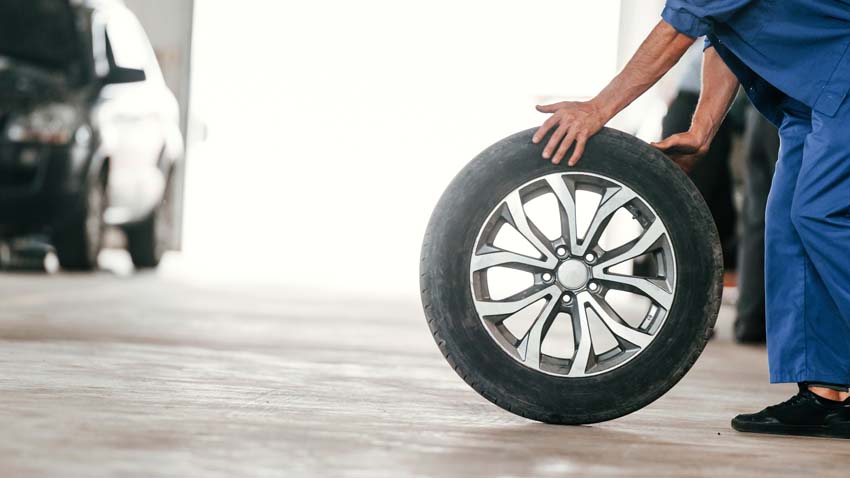
The following tips should help you get the most out of your tyres.
Start out with good tyres
Some tyre brands are household names, and most motorists have probably heard of Bridgestone, Continental, Goodyear, Michelin and Pirelli. They all have solid reputations: some of them are known for making high-performance tyres for motorsports and some for being go-to choices for car manufacturers to fit on their vehicles. Unfortunately, a good reputation is usually accompanied by a premium price tag.
If your annual mileage is very high then it may be worthwhile paying for the best. Conversely, if you use your car infrequently, or only for short journeys, then a budget brand may still serve you well. Check out tyre reviews online before buying: you could find some budget brands earning a surprising amount of praise. That said, there are definitely some cases where cheap is not cheerful. Poorly made tyres are a false economy and may even present safety hazards.
Think carefully before considering part-worn or retreaded/"remoulded" tyres
While they can save quite a lot of money up-front, used or retreaded tyres will not last as long as new ones and, like some cheap tyres, used or reconditioned tyres can compromise safety. There are strict regulations regarding the sale of used and reconditioned tyres but infringements are common. A sobering survey by TyreSafe revealed that up to 98% of used tyres sold in the UK were not regulation-compliant. Worse still, 34% were actually dangerous.
Look after what you've got
Following a simple maintenance routine can help you to drive further and more safely on your tyres. Some things should be checked and maintained on a weekly basis, while others may only need attention every few months. Hopefully, the following tips should help you avoid problems and get the most out of your tyres.
Know the correct pressure and maintain it
Your car's manual will give recommended inflation pressures for your tyres. The information is also often to be found on a plate riveted just inside the driver's door. Check the pressures weekly.
Driving with incorrectly inflated tyres can result in premature wear, reduced grip on the road, increased risk of a blow-out, increased fuel consumption and increased noise inside the car. Carry a tyre inflator in the car: they are small and inexpensive.
Check for damage
When you check your tyre pressures, take the opportunity to look for signs of damage, such as screws or other sharp objects embedded in the rubber or the tread. Look also for bulges, gouges or any exposed metal strands from inside the tyre's structure. If you find damage, get the tyre checked professionally. Cuts, bulges or other damage can mean your tyre is illegal, even if the tread still has plenty of depth left.
Check the tread
The regulations say that tyres must have at least 1.6mm of tread across the middle three-quarters of the tyre's width. The whole circumference of the tyre must comply with that limit. It is advisable to replace tyres by the time the tread depth has worn to 2mm. Driving with tyres that do not have enough tread can earn you three penalty points and £2,500 in fines.
Check wheel alignment
When you get tyres replaced, or when you take your car for its MOT test or service, make sure that you get the wheel alignment checked and corrected if necessary. Poor wheel alignment can cause premature and uneven wear on tyres.
Rotate your tyres
Even when wheels are well aligned, the nature of our roads, and the way most people drive, means that tyres will wear unevenly. Rotating tyres can help to ensure that tyres wear as evenly as possible. In this context, rotating means swapping the positions of tyres from front to rear, from side to side, or a combination of both.
There are several rotation schemes recommended by tyre manufacturers, but which method to use depends on the type of vehicle and the types of tyres fitted. For this reason, it is best to ask your dealership or mechanic to do it for you, or to refer to one of the manufacturers' guides online if you intend to do it yourself. Incorrectly rotating tyres can compromise safety or cause damage to the tyres.
Goodyear recommends rotating car tyres every 6,000 miles, and 4x4 tyres every 4,000 miles.
Drive carefully
Sudden or heavy braking and hard acceleration can both cause premature wear to your tyres, as can cornering too fast. Overloading or loading with weight unevenly distributed will also increase wear. Other things to avoid are scraping or mounting kerbs, and driving over potholes. Driving too close to the edge of the road can cause premature and uneven tyre wear. Grit tends to accumulate by kerbs and verges, and that grit can act as an abrasive, causing extra wear on the outside edges of the tyres on the passenger side.
Don't forget the spare
Whenever you carry out checks or maintenance on your tyres, make sure you include the spare. It is easily overlooked, especially on cars where it is tucked away, out of sight in a boot well. If you ever need to use it, you want your spare to be in good condition and ready to roll.
Only replace if you can't safely repair
Simple punctures to the middle, treaded area of a tyre can often be safely repaired by a garage or tyre specialist and, once properly repaired, the tyre should last as long as it would have without the puncture. Be aware, however, that damage to the wall of a tyre is not legally repairable.
